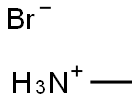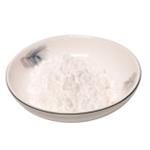Description
Methylammonium bromide (MABr) is a precursor for the synthesis of organic-inorganic hybrid perovskites for use in FETs, LEDs and PVs. It is a precursor of MAPbBr3 perovskites. Having a band gap of 2.3 eV (HOMO 5.68 eV, LUMO 3.38 eV) [1], MAPbBr3 perovskites have been used to tune the band gap of mixed MAPbX3 (where X is the halide I, Br and/or Cl mixtures). For this reason, bromide MAPbBr3 perovskites can be utilised as light absorbers for high-energy photons, and can serve as the front cell in tandem cells. This perovskite can provide a higher open-circuit voltage in perovskite solar cells than the iodide analogue. High-efficiency solar cells, with a VOC of up to 1.40 V, a fill factor (FF) of 79%, and a PCE of 6.7% have been reported for pure MAPbBr3 perovskite solar cells. It has also been demonstrated that MAPbBr3 nanoplatelets can be employed in light-emitting diodes, exhibiting bright photoluminescence (PL) at 529 nm, with a narrow spectral band and a quantum yield up to 85%.
Uses
Methylammonium bromide (MABr) can be used as a precursor in the preparation of methylammonium lead bromide based perovskite material with good optical properties, which include green emission, and photoluminescence. This material can further be utilized in the fabrication of renewable energy devices such as light emitting diodes(LEDs), perovskite solar cells (PSCs), and photovoltaic cells.
General Description
This product has been enhanced for energy efficiency. It has also been demonstrated that MAPbBr3 nanoplatelets can be employed in light-emitting diodes, exhibiting bright photoluminescence (PL) at 529 nm, with a narrow spectral band and a quantum yield up to 85%.





